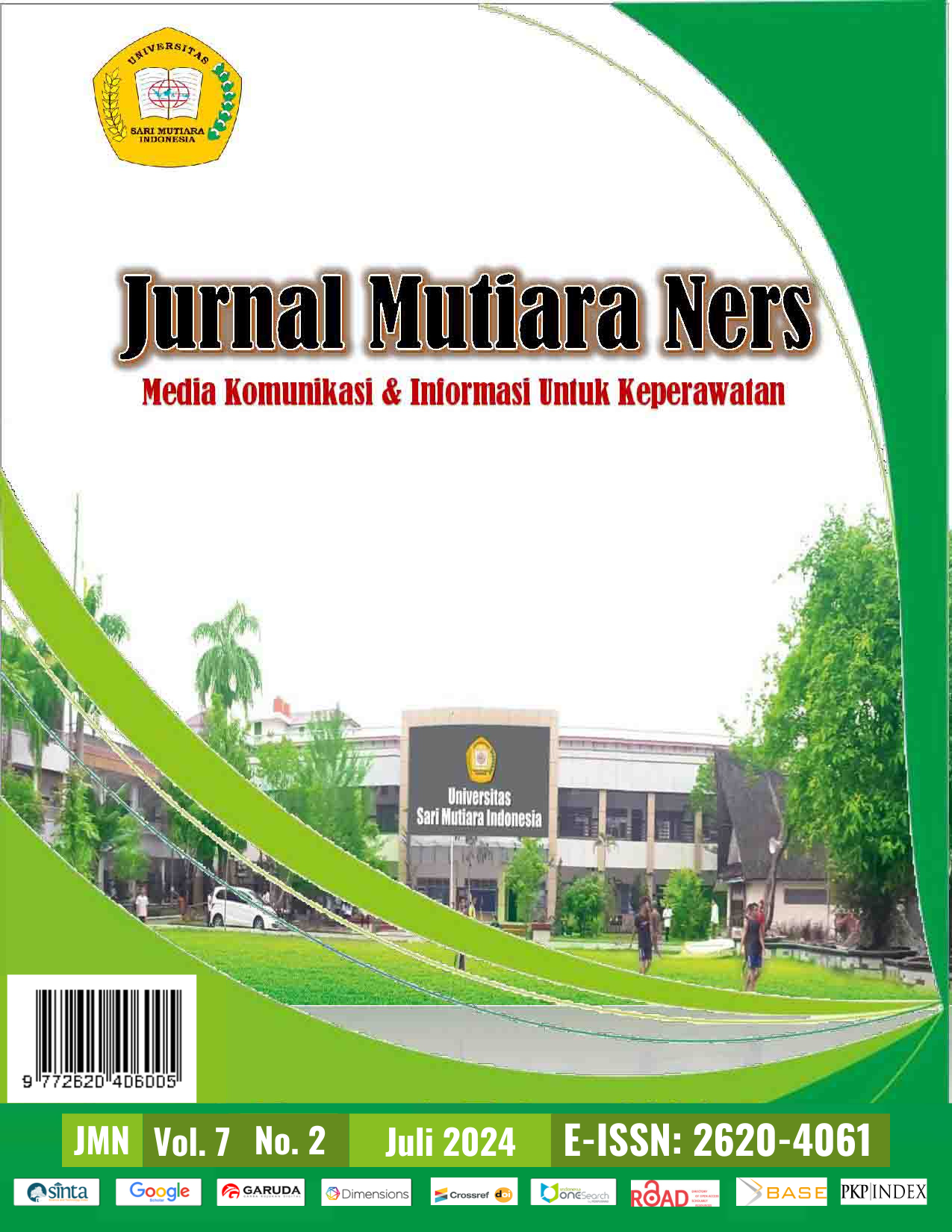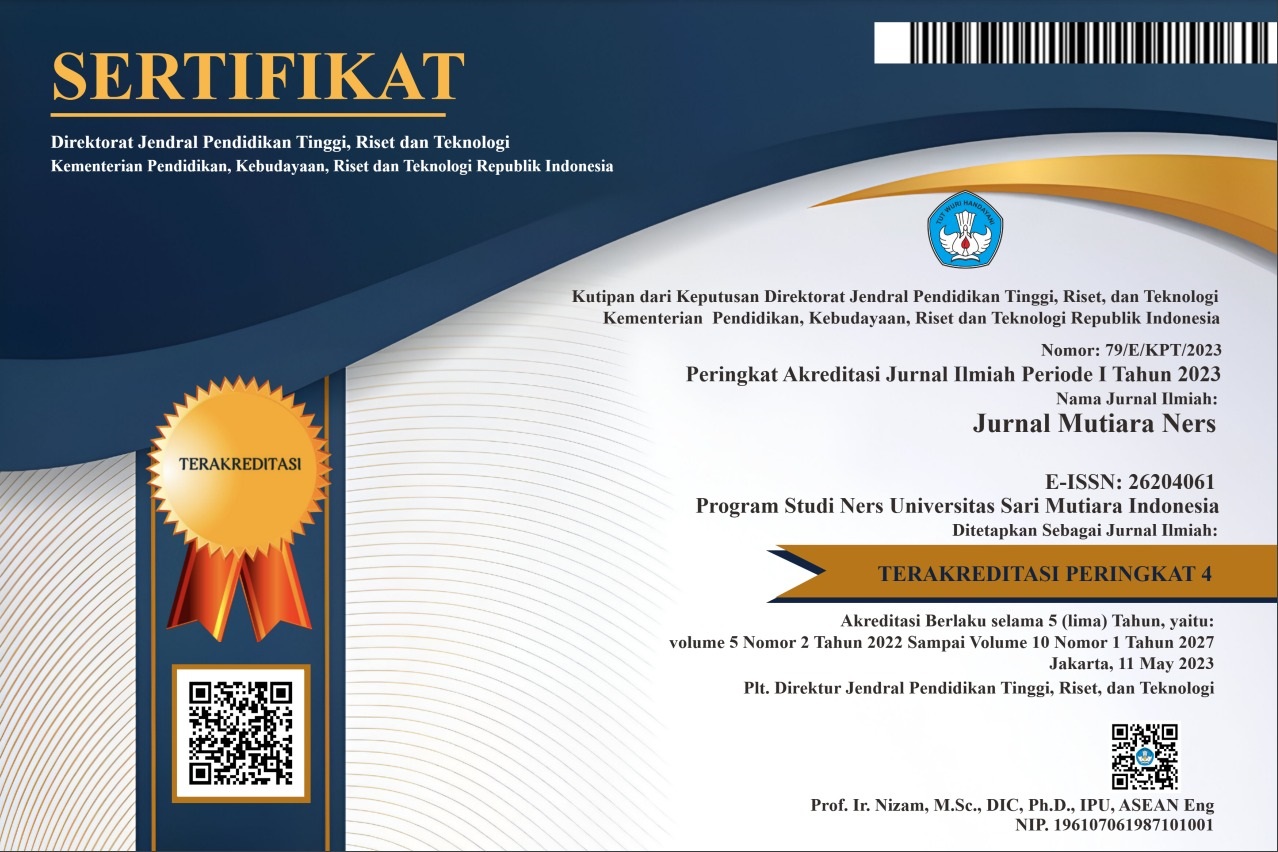PROFILE OF ULCUS DECUBITUS PATIENTS WHICH ARE ON BED REST AT HOSPITAL IN THE CITY OF MEDAN
Keywords:
Profile Of Ulcus Decubitus, Hospital In The City Of MedanAbstract
A study shows pressure ulcers are a secondary affliction that is experienced by many hospitalized patients, especially the patients with chronic diseases and patients who are very weak. However, the most frequently reported risk factors are older age, stay longer in the ICU, cardiovascular disease history, diabetes and stroke. This study aims to identify the profile of ulcers decubitus sufferers at Adam Malik General Hospital Medan and Hermina General Hospital Medan. The research method uses a quantitative descriptive approach. Data was collected using observation sheets and medical records. Sampling was done by chance with a total of 104 samples. Analysis of the data used is univariate analysis. Based on the results of the study, it wasfound that the average age of decubitus patiens was 55 years. The majority of decubitus patients are female is 55.8%. The patient’s average weight is 77 kg, average height is 161 cm, and the average body mass index is 24.8 (overweight). Based on the ulcer grade the majority is grade 2 with a percentage of 57, the average length of patient stay is 7 days. The diagnoses that led to 104 patients on bed rest varied widely. Most diagnoses were stroke (neurological disease) with a total of 48.1%.
Downloads
References
Widodo, A. (2017). Uji kepekaan instrumen pengkajian risiko dekubitus dalam mendeteksi dini risiko kejadian dekubitus di RSIS.
Chiari, P., Forni, C., Guberti, M., Gazineo, D., Ronzoni, S., & D’Alessandro, F. (2017). Predictive factors for pressure ulcers in an older adult population hospitalized for hip fractures: a prognostic cohort study. PloS one, 12(1), e0169909.
Gefen, A., Alves, P., Ciprandi, G., Coyer, F., Milne, C. T., Ousey, K., ... & Worsley, P. (2020). Device-related pressure ulcers: SECURE prevention. Journal of wound care, 29(Sup2a), S1-S52.
Kayser, S. A., VanGilder, C. A., & Lachenbruch, C. (2019). Predictors of superficial and severe hospital-acquired pressure injuries: A cross-sectional study using the International Pressure Ulcer Prevalence™ survey. International journal of nursing studies, 89, 46-52.
Kreutztrager, M., Voss, H., Scheel-Sailer, A., & Liebscher, T. (2018). Outcome analyses of a multimodal treatment approach for deep pressure ulcers in spinal cord injuries: a retrospective cohort study. Spinal cord, 56(6), 582-590.
LeMone, Burke, & Bauldoff, (2016). Keperawatan Medikal Bedah, Alih bahasa.Jakarta: EGC
Linggi, E. B. (2019). Intervention Model Of Decubitus Prevention Using Branden Scale Method To Decrease The Decubitus Risk Degree In Stella Maris Hospital Makassar. Jurnal Keperawatan Florence Nightingale, 2(1), 77-87.
MacDonald, J. (2022). A deep-dive thematic analysis of low-harm hospital-acquired pressure ulcers. British Journal of Nursing, 31(12), S8-S16.
Makrantonaki, E., Wlaschek, M., & Scharffetter‐Kochanek, K. (2017). Pathogenesis of wound healing disorders in the elderly. JDDG: Journal der Deutschen Dermatologischen Gesellschaft, 15(3), 255-275.
Moore, Z., Johansen, E., & Van Etten, M. (2013). A review of PU risk assessment and prevention in Scandinavia, Iceland and Ireland (part II). journal of wound care, 22(8), 423-431.
Nisak, K., Kristinawati, B., & Widayati, N. (2019, October). Aplikasi Massage Olive Oil untuk Mencegah Dekubitus pada Pasien Kritis di Ruang Intensive Care Unit Rumah Sakit Umum Pusat dr. Soeradji Tirtonegoro Klaten. In Prosiding University Research Colloquium (pp. 490-495).
Nofiyanto, M., & Ivana, E. (2018). Di Bangsal Penyakit Dalam Rumah Sakit Di Yogyakarta Nurses Role ’ S In Decubitus Prevention In Internal Medicine Ward Of Hospital In Yogyakarta, 7(1), 89–96.
NPUAP. (2016). Prevention and treatment of pressure ulcers: Clinical practice guideline. (Vol. www.NPUAP.).
Ozturk, I. (2022). Detected Frequency Of Bacteremia In Decubitus Ulcer Wounds And Factors Affecting Decisions To Treat. Authorea Preprints.
Peixoto, C. D. A., Ferreira, M. B. G., Felix, M. M. D. S., Pires, P. D. S., Barichello, E., & Barbosa, M. H. (2019). Risk assessment for perioperative pressure injuries. Revista Latino-Americana de Enfermagem, 27.
Potter, P. A., Perry, A. G., Stockert, P. A., Hall, A., & Peterson, V. (2016). Clinical Companion for Fundamentals of Nursing-E-Book: Just the Facts. Elsevier Health Sciences.
Riandini, R., Emaliawati, E., & Mirwanti, R. (2018). Prevalence, Prevention, And Wound Care Of Pressure Injury In Stroke Patients In The Neurology Ward. Belitung Nursing Journal, 4(6), 581-590.
Sardari, M., Esmaeili, R., Ravesh, N. N., & Nasiri, M. (2019). The impact of pressure ulcer training program on nurses’ performance. Journal of Advanced Pharmacy Education &, 3.
Surkan, M. J., & Gibson, W. (2018). Interventions to mobilize elderly patients and reduce length of hospital stay. Canadian journal of cardiology, 34(7), 881-888.
Tayyib, N., & Coyer, F. (2016). Effectiveness of pressure ulcer prevention strategies for adult patients in intensive care units: a systematic review. Worldviews on Evidence‐Based Nursing, 13(6), 432-444.
Thundiyil, J. G., O'Brien, J. F., Tymkowicz, A. E., & Papa, L. (2022). Is Lateral Decubitus Or Upright Positioning Optimal For Lumbar Puncture Success In A Teaching Hospital?. Journal of Emergency Medicine.
Vera-Salmerón, E., Rutherford, C., Dominguez-Nogueira, C., Tudela-Vázquez, M. P., Costela-Ruiz, V. J., & Gómez-Pozo, B. (2019). Monitoring Immobilized Elderly Patients Using a Public Provider Online System for Pressure Ulcer Information and Registration (SIRUPP): Protocol for a Health Care Impact Study. JMIR research protocols, 8(8), e13701
Published
How to Cite
Issue
Section
Copyright (c) 2024 Henny Syapitri, Lasma Rina Efrina Sinurat, Agnes Silvina Marbun

This work is licensed under a Creative Commons Attribution-ShareAlike 4.0 International License.


.png)





